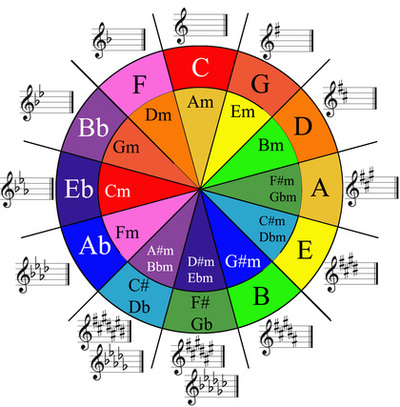Circle of Fifths
 The letters on the outside of the circle are the major keys and the letters on the inside are minor. The circle itself shows how many sharps of flats there are in each key, and the key signatures are on the edge.
The letters on the outside of the circle are the major keys and the letters on the inside are minor. The circle itself shows how many sharps of flats there are in each key, and the key signatures are on the edge.
This is called the Circle of Fifths because each note is a perfect fifth away from another. A perfect fifth is the distance of 7 notes tones: A, A#, B, C, C#, D, D#, E.
When we go clockwise around the circle, we are going "up a fifth". This is also called adding a sharp (because of the what it does to the key signature). When we go counter-clockwise, we are going "down a fifth". This is also called adding a flat.
When playing most kinds of music, the most common chords will be the chord of the key you are working in, and the chords on either side of it on the circle. For example, if you are playing in the key of C, you'll likely use F and G as well.
When writing songs, sometimes it can be difficult to come up with interesting chord progressions. We can use the chart for this. The closer two chords are on the circle, the better they will sound together. Part of the reason this is used so much in music is because they sound good. To make it more interesting, take the key you are in (for example 'D') and leap to another chord (we'll use C). Then work back through the chords toward home base again and use the chords around it. Try playing this on your instrument to see how it sounds.
Sample chord progression : D C G D G A D